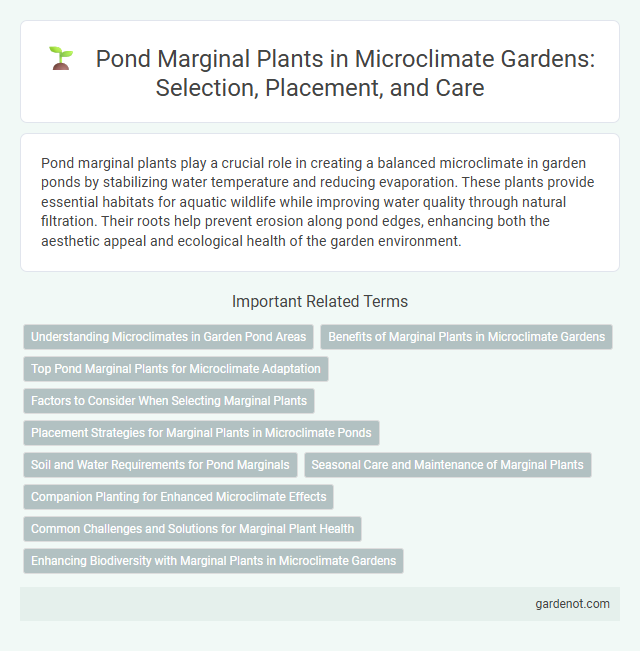Pond marginal plants play a crucial role in creating a balanced microclimate in garden ponds by stabilizing water temperature and reducing evaporation. These plants provide essential habitats for aquatic wildlife while improving water quality through natural filtration. Their roots help prevent erosion along pond edges, enhancing both the aesthetic appeal and ecological health of the garden environment.
Understanding Microclimates in Garden Pond Areas
Pond marginal plants play a crucial role in shaping microclimates within garden pond areas by moderating temperature and humidity levels along the water's edge. These plants create shaded zones that reduce water evaporation and provide shelter for aquatic and terrestrial wildlife, promoting biodiversity. Strategic placement of species like cattails and irises enhances moisture retention in the soil, contributing to a balanced microenvironment ideal for both plants and pond inhabitants.
Benefits of Marginal Plants in Microclimate Gardens
Marginal plants in microclimate gardens enhance water quality by filtering pollutants and reducing algae growth, creating a healthier pond ecosystem. Their extensive root systems stabilize pond edges, preventing soil erosion and maintaining structural integrity. These plants provide habitat and breeding grounds for beneficial insects and amphibians, increasing biodiversity and promoting natural pest control.
Top Pond Marginal Plants for Microclimate Adaptation
Top pond marginal plants such as Cattails (Typha latifolia), Pickerelweed (Pontederia cordata), and Water Lilies (Nymphaea spp.) play a crucial role in microclimate adaptation by stabilizing pond edges and improving water quality through natural filtration. These species provide essential habitat for aquatic wildlife while moderating temperature fluctuations around the pond margin. Their dense root systems enhance soil retention, reducing erosion and supporting a resilient microenvironment.
Factors to Consider When Selecting Marginal Plants
When selecting pond marginal plants for a microclimate garden, consider their tolerance to water depth, light exposure, and temperature fluctuations to ensure healthy growth. Choose species that support local biodiversity and provide habitat for aquatic wildlife, enhancing the ecosystem balance. Soil type and nutrient availability must also align with plant requirements to prevent nutrient imbalances and maintain water quality.
Placement Strategies for Marginal Plants in Microclimate Ponds
Optimal placement of pond marginal plants in microclimate gardens involves positioning species such as Carex, Iris, and Lobelia at shallow pond edges to enhance water filtration and provide habitat diversity. Strategic spacing ensures adequate sunlight exposure and airflow, crucial for temperature regulation and reducing algae growth within the pond ecosystem. Integrating native sternbergia and juncus varieties along varied depth gradients promotes ecological balance and supports beneficial microhabitats specific to localized microclimates.
Soil and Water Requirements for Pond Marginals
Pond marginal plants thrive in consistently moist to waterlogged soils with high organic content, making them ideal for wetland edge environments. These plants require nutrient-rich substrates with good water retention to support root oxygenation and growth, often benefiting from shallow water depths between 5 to 20 cm. Maintaining balanced water levels and avoiding stagnant conditions ensures healthy development and prevents root rot in pond marginal vegetation.
Seasonal Care and Maintenance of Marginal Plants
Pond marginal plants require seasonal care to thrive, including regular trimming of dead or yellowing foliage in spring and autumn to promote healthy growth. Fertilize these plants with aquatic plant fertilizer during the growing season, typically from late spring to early summer, to enhance blooming and root development. Monitor water levels and remove debris to prevent stagnation, ensuring marginal plants receive adequate sunlight and maintain their role in stabilizing pond edges and improving water quality.
Companion Planting for Enhanced Microclimate Effects
Pond marginal plants such as cattails, irises, and marsh marigolds create a balanced microclimate by stabilizing water temperature and enhancing biodiversity. Companion planting with species like sedges and rushes improves oxygen levels, supports beneficial insect habitats, and reduces algae growth through natural nutrient absorption. This synergistic plant arrangement optimizes water quality and promotes a sustainable, thriving pond ecosystem.
Common Challenges and Solutions for Marginal Plant Health
Pond marginal plants often face issues like waterlogging, nutrient imbalances, and pest infestations that hinder their growth and health. Managing water levels to prevent root rot, using balanced aquatic fertilizers, and introducing natural predators can effectively mitigate these challenges. Regular monitoring and maintaining appropriate light conditions also promote robust growth and resilience in marginal plants.
Enhancing Biodiversity with Marginal Plants in Microclimate Gardens
Pond marginal plants play a crucial role in enhancing biodiversity within microclimate gardens by providing habitat and food sources for a variety of aquatic and terrestrial species. Species such as cattails, irises, and sedges stabilize pond edges, improve water quality through filtration, and create microhabitats for insects, amphibians, and birds. The diverse structural layers and root networks of these plants support a balanced ecosystem, fostering pollinator activity and natural pest control.
Pond marginal plant Infographic

 gardenot.com
gardenot.com